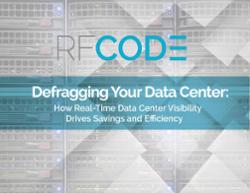Thoughts from Datacenter Dynamics Enterprise
While exhibiting at the recent DatacenterDynamics Enterprise event in New York City, I had the opportunity to attend a thought-provoking session from Sabey Data Centers: Technology innovation in the data center - improving PUE and WUE and the Mobile Commissioning Assistant. While the VP of Operations was highlighting the different designs and builds of their data centers, he also addressed the different cooling models that each facility used. It was interesting to learn how the various data centers dealt with cooling by using different techniques, each unique to the facility’s layout and surrounding environment. It led me to think about the link between cooling and RF Code’s work in data center optimization, and how no cooling model can be complete without a variety of monitoring solutions.
 One of the most intriguing points in the Sabey presentation had to do with a demonstration on how hot-aisle containment was being successfully used at one of the company’s high-density data centers. At its most basic, hot-aisle containment encloses the hot aisle in order to collect the hot exhaust air being produced by the IT equipment. This releases the remainder of the data center to become a robust cold-air return plenum. If done correctly, the hot-aisle is contained (hence the name) and the hot and cold air streams are separated, eliminating the mixing of hot and cold air. This is an efficient and proven system. However, it also reminded me that without real-time continuous monitoring of the containment system: temperature, humidity, power usage, etc., data center operators run a substantial risk of enduring a downtime event.
One of the most intriguing points in the Sabey presentation had to do with a demonstration on how hot-aisle containment was being successfully used at one of the company’s high-density data centers. At its most basic, hot-aisle containment encloses the hot aisle in order to collect the hot exhaust air being produced by the IT equipment. This releases the remainder of the data center to become a robust cold-air return plenum. If done correctly, the hot-aisle is contained (hence the name) and the hot and cold air streams are separated, eliminating the mixing of hot and cold air. This is an efficient and proven system. However, it also reminded me that without real-time continuous monitoring of the containment system: temperature, humidity, power usage, etc., data center operators run a substantial risk of enduring a downtime event.
Whether utilizing wired or wireless monitoring tools, owner/operators need to be receiving a wealth of information from their data centers so that they can effectively analyze current conditions and address problems before they happen. It seems obvious, but thermal sensors are key to maintaining a successful hot-aisle containment system. To both increase efficiency and prevent downtime, the room’s thermal parameters must be continuously monitored and adjusted to ensure proper (and optimal) performance. For example, a properly monitored hot-aisle containment system allows for cooling systems to be set to a higher supply temperature, which in turn will save energy and increase cooling capacity, all while operating within safe operating temperatures. In contrast, uncontained cooling systems are restricted to a much lower set point than what is needed by the IT equipment in order to avoid hot spots. This type of overcooling system works, but is far from energy efficient. A properly monitored hot-aisle containment system is so valuable because it creates a scenario where the hottest possible return air is going back to the cooling unit while simultaneously allowing for significant raises in cold air supply temperatures.
As hinted above, an additional benefit of a properly monitored hot-aisle containment system is a tremendous reduction in hot spots. This is because a contained system causes the cooling unit supply air to reach the front of IT equipment before it has a chance to blend with hot air, creating a favorable scenario of uniform IT inlet air temperatures. However, no system is perfect, and monitoring sensors should still be in use to provide ample warning in the unlikely event that a hot spot begins to form. Of course, an optimum monitoring solution would also be providing data so that data center operators have the critical information necessary to increase their efficiency, but that’s a topic for another post ...
Want to learn more about how wire-free environmental monitoring drives savings and efficiency in your data center? Download our eBook today!



